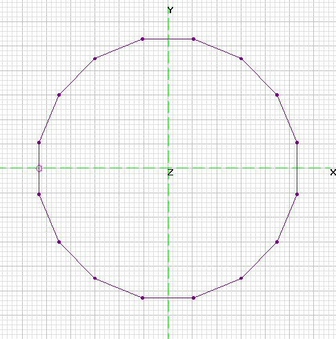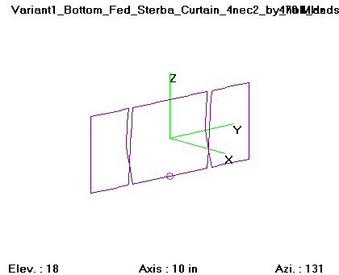 | 1.
UHF Loop (Parallel-to-Ground) NOT for TV (16Sep2018)UHF Loop (Parallel-To-Ground) Antenna analyzed using 4nec2.
Very Irregular Performance NOT suitable for Wideband UHF Application. |
| 436 Visits
27 Images
Shared Album | |
|
 | 2.
UHF Fractal Pisan-Cross (5 Aug 2013)UHF Fractal Pisan-Cross analyzed using 4nec2. [Only Mod2 shown below.]
Named after: http://en.wikipedia.org/wiki/Pisan_cross
Mod0 version adds GW500 Simulated SOURCE Wire to close the Fractal: non-symmetric, disfunctional Antenna Pattern.
Mod1 version uses centrally located GW487 as Simulated SOURCE Wire: symmetric, but disfunctional Antenna Pattern.
Mod2 version adds GW501 to interconnect Left and Right halves of the Cross: symmetric, SWR Max=4.1,
usable 5-10 dBi Raw Gain on many channels, but Raw Gain Holes on 470, 566 & 698 MHz.
Mod3 version comments out GW238 & GW487 so only GW501 interconnects Left & Right halves.
Eliminates Raw Gain Hole on 566 MHz, but SWR Max=5.8 needs improvement. |
| 4798 Visits
28 Images
Shared Album | |
|
 | 3.
HiVHF+UHF Circular Pancake Loop FakeOmni (10 Aug 2013)Hi-VHF+UHF Circular Pancake Loop (Fake Omni) analyzed using 4nec2.
Loop Center-Center Diameter assumed to be about 27-in, based on info found at fol. Halo VuTV website:
http://www.etsy.com/listing/150171803/halo-vutv-omnidirectional-uhf-vhf-long
Analysis revealed that the Hi-VHF Azimuthal Response is very irregular...NOT Omni....and UHF is even worse.
Three versions were analyzed, based on whether the portion opposite from the Feedpoint is connected or there is a Gap cut into the Loop:
a) Loop NOT CUT opposite from Feedpoint.
b) Loop with 5.25-in Gap CUT opposite from Feedpoint.
c) Loop with 1.0-in Gap CUT opposite from Feedpoint. |
| 3364 Visits
63 Images
Shared Album | |
|
 | 4.
2-Meter Cubical Quad-1: Howzit for TV? (14 Jun 2010)2-Meter (144-148 MHz) 4-Element Cubical Quad Antenna, dimensions per On-Line Calculator.
Q: Suppose it was connected to a TV.....analyzed using 4nec2.
Several On-Line Calculators return the same design, such as:
http://www.csgnetwork.com/antennae5q2calc.html
Ch2-6 & FM Band: Mostly omnidirectional, but with no more Raw Gain than Rabbit Ears and Very Excessive SWR.
Ch7-13: About 3 dBi Raw Gain, but with maximum in the REVERSE direction. SWR is still excessive, although using a
300-ohm Balun vice normal 50-ohm connection can provide a moderate improvement.
UHF: Azimuthal Patterns are very inconsistent with very low Raw Gain. Maximum Gain is on Rear Sidelobes on Ch14,
off to the Sides on Ch32, Forward on Ch51 and off to the Sides on Ch69. SWR is excessive on many channels,
although using a 300-ohm Balun vice normal 50-ohm connection can provide a significant improvement.
SUMMARY: Poor SWR, but Raw Gain is minimally usable on Ch7-13. UHF is extremely poor. |
| 12141 Visits
11 Images
Shared Album | |
|
 | 5.
2-Meter Cubical Quad-2: Howzit for TV? (17 Jun 2010)2-Meter Cubical Quad-2: Howzit for TV? analyzed using 4nec2.
Dimensions from "Simpleton's Guide to Quad Antennas":
http://www.artscipub.com/simpleton/simp-quad.asp
Modeling the above dimensions in 4nec2 reveal a significant SHIFT upwards in the resonant frequency to about 151 MHz.
vice 144-148 MHz needed for 2-Meter Band, SWR was Excessive 4:1.
Hi-VHF TV Band Raw Gain was usable, but max was towards the REAR of the antenna. SWR with 50-ohm load
(as required for 2-Meter operation) was Excessive. Inserting a 4:1 Balun reduced SWR to an acceptable 2 to 3.
UHF TV Band Raw Gain was quite low for an antenna of this size with very inconsistent Azimuthal Antenna Patterns. |
| 6154 Visits
19 Images
Shared Album | |
|
 | 6.
V- & H-Polarized X396 Fence (5 Sep 2009)Six Sticks on a Wire "Fence" Antenna (X396-VPol and X396-HPol) analyzed using 4nec2.
The first one is Vertically Polarized and the second is Horizontally Polarized.
Note that the Azimuthal Response for X396-HPol is not symmetric and varies considerably with frequency. |
| 7969 Visits
5 Images
Shared Album | |
|
 | 7.
Yet Another UTube Defect (26 July 2009)Yet another UTube Defect analyzed using 4nec2.
Raw Gain peak is very Narrowband and SWR is even more Narrowband and doesn't align with the Gain peak.
Way too small to be a variant of either the (similiar???) Bruce Array or Sterba Curtain,
which have half-wavelength and sometimes also quarter-wavelength radiators. |
| 8603 Visits
13 Images
Shared Album | |
|
 | 8.
Bruce Array (26 July 2009)Variant Bruce Arrays analyzed using 4nec2, based on Fig 8.13 in Joe Carr's "Antenna Toolkit, 2nd Ed":
http://books.google.com/books?id=q11p4eduQGsC&pg=PA166&lpg=PA166&dq=Joe+Carr+Six+Shooter&source=bl&ots=KLrTrEdlp4&sig=GDBun3xjKTV3C_eOi7N9BpXW5G4&hl=en&ei=-nRqSsiyHZKBtwfp-4zHBQ&sa=X&oi=book_result&ct=result&resnum=1
Actually these are variations on the "True" Bruce Array: http://rudys.typepad.com/ant/files/antenna_array_80160m.pdf
Although these Bruce Array Variants provide Raw Gain across most of the New UHF TV Band, frequency range for low SWR is very small.
Unsuitable for either Hi-VHF or UHF TV Bands due to the need for a tunable matching network. |
| 6181 Visits
12 Images
Shared Album | |
|
 | 9.
Sterba Curtain (26 July 2009)Sterba Curtains analyzed using 4nec2.
Variant1 (1/2 +2/4 wave-lenghts) and Variant2 (2/2 + 2/4 wave-lengths) are described here:
http://www.w8ji.com/curtain%20sterba%20USIA%20array.htm
Variant3 (3/2 + 2/4 wave-lengths WIDE) is described here: http://www.antennex.com/shack/Jul05/sell.html
Although Sterba Curtains provide Raw Gain across most of the New UHF TV Band, frequency range for low SWR
is very small for Variant1 and Variant2.
Variant3 has slightly better SWR, but only over part of the new UHF band....and is much better at 600-ohms.
Hence these are unsuitable for either Hi-VHF or UHF TV Bands due to the need for a tunable matching network. |
| 9445 Visits
16 Images
Shared Album | |
|
 | 10.
Six Shooter (26 July 2009)Six Shooter analyzed using 4nec2.
Description found here:
http://books.google.com/books?id=q11p4eduQGsC&pg=PA166&lpg=PA166&dq=Joe+Carr+Six+Shooter&source=bl&ots=KLrTrEdlp4&sig=GDBun3xjKTV3C_eOi7N9BpXW5G4&hl=en&ei=-nRqSsiyHZKBtwfp-4zHBQ&sa=X&oi=book_result&ct=result&resnum=1
Raw Gain peak (8 dBi) was fairly narrow, although always above 4 dBi.
SWR (300-ohm) was also narrowband and only partially overlapped Gain peak. |
| 7912 Visits
6 Images
Shared Album | |
|